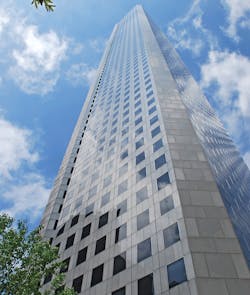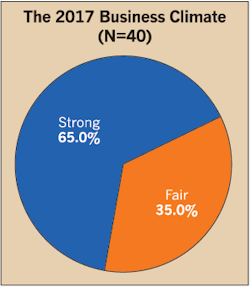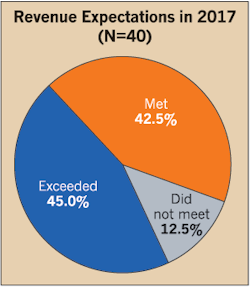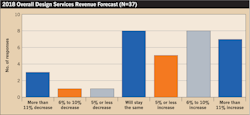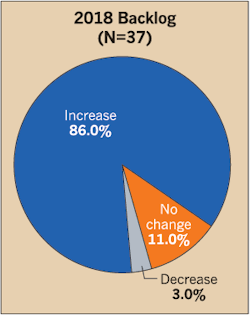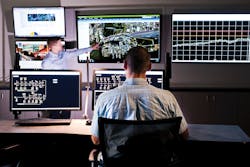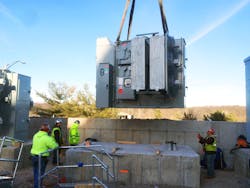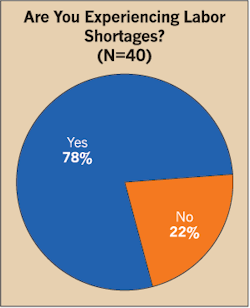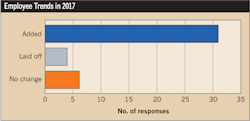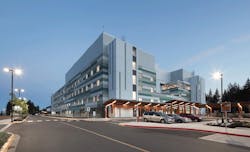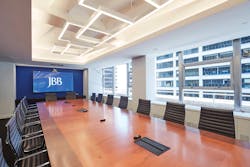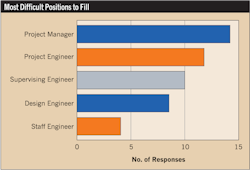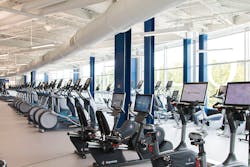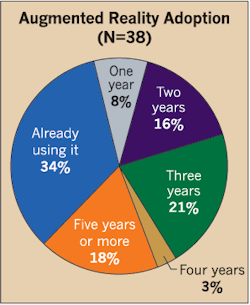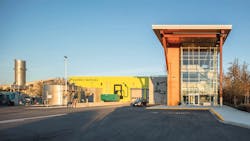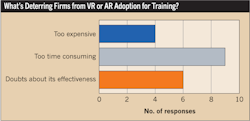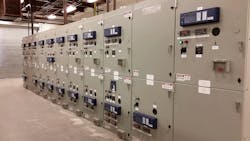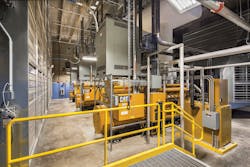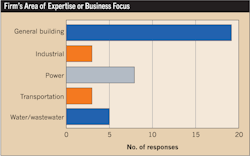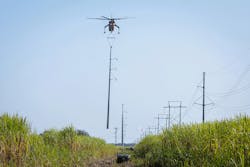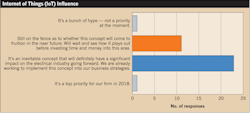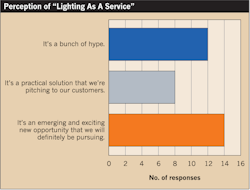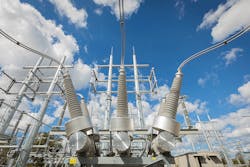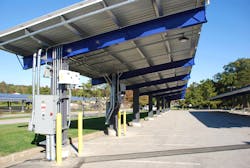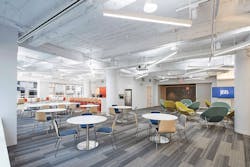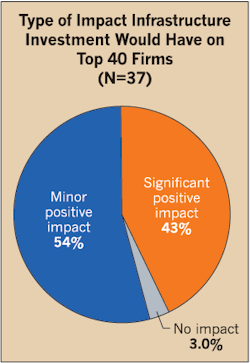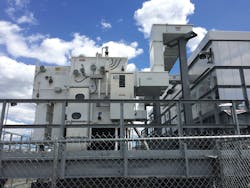Decelerating Growth, Accelerating Change: EC&M’s 2018 Top 40 Electrical Design Firms Special Report
Construction engineering and design firms often get the first whiff of economic stagnation. Orders drop off and backlog shrinks as developers pull in their horns amidst deteriorating economic fundamentals. But the air must have smelled like a rose throughout 2017 for electrical design firms, as construction spending scaled new heights, and requests for engineering electrical systems for new projects ramped up.
EC&M’s newest annual survey of electrical design firms found that as seasonally adjusted annual construction spending tallied by the Commerce Department grew from $1.2 trillion to $1.25 last year, reported 2017 combined revenues of companies on the EC&M 2018 Top 40 Design Firms roster followed suit, putting many of their executives in a bullish stance.
“A lot of folks are coming to us for proposals, and this market still looks hot,” says Jim Sattem, a principal with Interface Engineering (No. 23), a Portland, Ore.-based firm that reported revenue growth of nearly 12% to $16 million last year and expects similar growth in 2018. “We’re going to ride this bubble.”
On the other coast, Mark Torre, a principal with Jaros Baum & Bolles (JB&B) (No. 14), New York, sees no letup in demand for design services in the surrounding tri-state area that fueled reported 12.5% revenue growth last year for his firm to $27 million.
“The market is exploding with more demand in health care, commercial, and residential,” he says. “RFPs are coming in constantly. Every hospital in the area seems to be building or renovating facilities, and electrical is a big part of all of that.”
Both companies were among the two-dozen Top 40 firms that logged revenue growth from 2016 to 2017. Combined, this year’s Top 40 firms reported 2017 electrical design revenues of $2.22 billion — good for a 3.4% gain over those on the 2017 Top 40 list. That’s a marked growth reduction for the group — down from 16% last year and 28% the year before — but given the recent growth trajectory, not unexpected. Whether this is a pause ahead of a resumption of double-digit growth or a sign of a coming retrenchment is unknown. But the survey found an abundance of optimism that the good times can last.
Reflecting on 2017, 65% of respondents characterized the business climate as strong, while 35% rated it fair, and none saw it as weak. That’s a big change from last year, when only 53% said the climate was strong, and 45% called it fair (Fig. 1).
That assessment undoubtedly is linked to the construction economy’s health, but it may also reflect an understanding that thoughtful, informed, and cutting-edge electrical design is in increasingly high demand on so many projects. That’s partly why Ray Kowalik, CEO of Burns & McDonnell (No. 1), talks up a favorable business climate and prospects for continued revenue growth at the Kansas City, Mo.-headquartered firm. While electrical transmission and distribution projects are the firm’s bread and butter — and demand for them is off the charts — the firm’s heavy electrical design focus is an emerging gateway to other developing markets.
“One of our big, growing markets is data centers,” he says. “If you think about how much data we’re consuming — and the growing need for storing all of that information — you see the chance for incredible growth. These facilities are basically shell buildings that contain massive electrical systems.”
Another market that feeds the firm’s optimism is aviation. Kowalik says new, expanded, and refurbished airports will be a source of revenue growth. They’re a natural for the firm because new designs require increasingly sophisticated electrical systems.
“Our aviation business director has proposals out across the nation for $4-plus billion,” he says. “They require a lot of electrical work to address security, lighting, passenger service, and shopping and restaurant areas, so this should be a booming area for quite a while.”
More work in that sector alone could easily fulfill the firm’s projection of a 2018 revenue increase on the order of 6% to 10%, which would be a respectable follow-up to a 2017 gain of 15% that followed a slightly down 2016. Growth exceeded the firm’s prediction of 5% or less, propelling its Top 40 list-leading revenue to $822 million, far outpacing those of the list’s No. 2 firm, Stantec, Inc., which logged $244 million. Burns & McDonnell was part of nearly half the Top 40 whose 2017 revenues came in higher than expected (Fig. 2). By comparison, the year before just 35% said 2016 revenues topped expectations.
Many growth drivers
Burns & McDonnell was one of nine 2018 Top 40 firms that predicted 2018 revenue growth in the 6% to 10% range, and one of 25 that predicted some degree of revenue increase. Notably, only five firms saw their revenue declining (Fig. 3).
Increases in 2018 revenue will come from a variety of sources, firms say, including more work from existing clients, new clients, and possibly even fee hikes in a seller’s market. Backlogged work could also factor in. That increased for 74% of the Top 40 in 2017 — down four percentage points from 2016 — and is seen increasing again this year by 86%, optimistic but down from 95% who forecasted a backlog increase for 2017 (Fig. 4 and Fig. 5).
At KCI Technologies Inc., (No. 22), Sparks, Md., the revenue picture looks strong, partly because the firm continues to increase its involvement in the MEP sector after years of focusing on civil engineering, says Wayne Martin, practice leader-electrical. After a 41% revenue spike last year, the firm’s electrical work should expand again, he says, both as part of comprehensive MEP design contracts and electrical-centric projects.
“I see more work for us this year,” he says. “We’ve been heavy on reaching out to new clients and developing new relationships, which leads to more proposals. And we are getting involved in more electrical-only projects such as solar, power analysis, selective coordination, and arc flash studies for clients.”
By February, Triad Consulting Engineers, Inc., (No. 11), Morris Plains, N.J., had already booked as much electrical business as it did in all of 2017, says the firm’s President Ron Regan. He sees revenues coming in at least 11% above the $30 million generated last year, which was 32% higher than the year before and the largest increase since 2004.
“One of our major clients, an oil company, announced plans to redo refineries, and its electric budget for that is $100 million a year for the next eight years, so we’ll get some of that,” he says.
Revenue will also get a boost from more solar, CHP, and microgrid projects, he says, which are booming in the Northeast where concerns about grid resiliency are growing.
JB&B sees revenues 6% to 10% higher as the firm expands its electrical design footprint, Torre says. Growth will come partly from staying selective and both finding and sticking with clients willing to reward the firm for quality work.
“There is always pressure on fees, but we’ve decided we’re going to maintain our service level at a high rate and assume our clients will pay us for that,” Torre says. “It’s unfortunate that design services are becoming a commodity in some respects.”
Staffing struggles
One way to combat that is by staying fully staffed with the best electrical design talent in the market. But that continues to be a struggle for most firms. As in recent surveys, more than three-quarters of respondents say they have positions to be filled (Fig. 6). Many are confronting a perfect storm of retirements, turnover, and difficulty finding both young prospects and experienced talent. And it’s all coming at a time of growing demand; 31 of 40 companies say they added employees in 2017, and 34 say they’re looking to staff up this year (Fig. 7 and Fig. 8).
John Burns, COO and vice president of Burns Engineering, Inc., (No. 16), Philadelphia, needs to hire perhaps a dozen electrical designers this year as the firm’s backlog and revenue are projected to grow following a year when its revenues were flat. He’s guessing it will take time to fill open jobs, particularly the more senior-level slots.
“I go to industry functions, and there’s constant discussion about the talent issue,” he says. “Everyone’s taking from other companies, and that’s driving up the cost, too.”
Shah & Associates, Inc., (No. 35), Gaithersburg, Md., is looking to hire even in a business climate Principal Shreedhar Shah calls only “fair.” But it’s a challenge when the crop of young engineers schooled in power systems, the firm’s specialty, remains thin.
“There are not as many people going into that field as there used to be,” he says. “But it’s even tougher to find the more experienced engineers today by far.”
To navigate its staffing challenges, Triad has stepped up efforts to bring retired engineers back as contractors. In addition to offering ready experience, Regan says, this approach controls labor costs and provides workforce flexibility.
“Having contracted or leased employees will be good if there’s a downturn,” he says.
The hiring challenge is compounded by competition from other engineering disciplines. Interest in electrical engineering careers continues to skew toward digital electronics applications. That means fewer engineering graduates for companies like Burns & McDonnell to cherry pick.
“We’re a very electrical design-intensive business because of the lines we’re in, but traditional electrical engineer jobs are the hardest for us to fill,” says Kowalik.
Transitioning strategies
With experienced engineers harder to find and positions that demand experience, like project manager and supervising engineer, particularly hard to fill (Fig. 9), more Top 40 firms are looking for ways to sculpt raw design talent. Mentorship programs, on-the-job training/shadowing, and pairing new hires with mid-level engineers in training are the most common ways firms facilitate knowledge transfer between experienced engineers and recent graduates (Fig. 10).
Burns Engineering uses an intergenerational team approach to bringing junior engineers along. Informally pairing recent hires with more senior staffers is an approach Burns says melds the knowledge of experienced designers with the drive and motivation of young newcomers.
“It’s set up as a sort of technology exchange committee where newer engineers can attend lunch-and-learn style presentations and find mentoring opportunities in the organization,” he says.
To complement a strong college recruiting program, JB&B has maintained a formal training structure that helps accelerate the productivity of new hires. Dubbed “JB&B University,” the program imparts both technical knowledge and an understanding of how the firm does business.
“It’s organized so that class members are all taught at the same rate, and it ties into our interest in investing in our people and helping them grow here,” says Torre.
Advances in technology could come to the aid of design firms struggling to find engineering talent in a tight market. Laser scanning, 3-D modeling, and BIM tools are already helping designers be more productive, but more are on the way. One is augmented reality, a software-based tool that allows prospective designs to be visually and virtually “experienced” in the design and construction phase rather than simply “read.” AR is drawing interest for its ability to help produce better designs more quickly, and a few Top 40 firms say they’re starting to use it (Fig. 11).
At Mott MacDonald (No. 3), Iselin, N.J., AR is getting a closer look as part of a concerted effort to bring design deeper into the digital world, says Spokesperson Don Flood. The firm recently established a “digital ventures” group that will, among other things, “come up with innovative solutions to improve how we construct projects.” Helping clients better visualize complex project designs is a priority, and AR could be a big help, he says.
AR is also being used more by Burns & McDonnell. It’s helping designers show clients in greater detail how projects will look after they’re constructed, and its capabilities are also improving the overall design process.
“It’s helping to automate some of the mundane tasks and takes some of the low-value tasks out of the designer’s hands,” says Kowalik.
AR, though, is still new enough that most say they’re measuring meaningful adoption of it in years. The primary reason: uncertainty about its ultimate value and time (Fig. 12).
Evolving markets
Automation may ultimately help firms with staffing issues, but, until then, formalized staff education and targeted hiring for experience and knowledge could grow to become more important to electrical design firms as markets for their services evolve. The roster of “hot” and “cool” markets changes with economic trends, technology upgrades, and improvement cycles in sectors — and that can change how design firms orient themselves to the market over time. This year’s Top 40, for instance, identified the power (utilities/T&D) market as the most active, whereas health care got the most mentions from last year’s group. This year, it dropped to fourth. The education/institution market dropped out of the top five this year after making the top three last year (see Table 1).
Nevertheless, Baltimore-based RMF Engineering, Inc., (No. 26) is finding more work designing medium-voltage distribution systems for university campuses, as well as government agencies and health care entities. As systems age, they’re being replaced with ones that now also incorporate emerging renewable power and co-generation capabilities, says Andrew Hay, electrical infrastructure manager. That’s put a premium on hiring and training designers with that specialized knowledge.
“There’s a lot of aging electrical infrastructure that needs to be addressed, but that’s in conflict with some of the training of younger engineers,” he says. “We’re losing a lot of knowledge on how to build distribution systems.”
Renewable energy projects were one of the top revenue generators for KCI in 2017, and the firm’s electrical practice leader sees growing promise in that market as private solar farm developers need assistance with designs, permitting and contractual agreements that allow integration with utility grids.
“Local utilities are also reaching out to companies like ours to help with renewable projects that are increasingly required as part of merger agreements,” Martin says. “We’re marketing our services in this area.”
Burns Engineering is doubling down on markets where barriers to entry are high, such as rail and aviation work, says COO Burns. The firm’s advanced power systems group targets that market, notably airports, with designs that enhance systems resiliency and redundancy with smart technologies, metering, and load monitoring.
“We’re interested in highly specialized services that transcend geography,” he says. “You’re not going to find a railroad traction power systems specialist in every town.”
Job opportunities
But market specialization, by definition, isn’t for everyone in electrical design. While markets like power/T&D and water/wastewater almost demand that expertise and can justify a specialist orientation, the Top 40 remains dominated by firms working in the “general building” arena (Fig. 13).
That market is not only broad, but also brimming with opportunity and new challenges that will test electrical designers. Buildings of all types are incorporating more “smart” elements delivered through complex electrical infrastructures. That’s pushing more electrical design firms, even generalists, to become versed in components of advanced building infrastructure. Many Top 40 firms see future revenues in the commercial building space being enhanced by such projects, ranging from building automation systems to solar PV (Table 2).
Interface Engineering is seeing growing demand for building lighting control and building management systems, as well as solar PV. Principal Sattem says schools are a top market for more sophistication, and more buildings of all types are being designed to net-zero-energy-ready or -capable status.
“There’s a higher level of expectation to design more complex and better coordinated building systems, and more highly efficient buildings,” he says.
Heavily engaged in commercial and institutional building construction and upgrade work, JB&B’s electrical designers are constantly challenged to go well beyond conventional electrical systems, Torre says. More buildings are being designed to WELL Building standards; renewable energy components are becoming routine; and advanced lighting and controls systems are standard fare.
“After a move to greater standardization, the cycle of lighting design is now moving back to more complexity,” he says.
One element of that is lighting’s emerging role as a potential networking backbone for the Internet of Things (IoT). A sensor-based and controls-oriented IoT is a core element of smart, connected buildings, and could grow to become a routine consideration in electrical systems design. It may already be here, as a small majority of the Top 40 say the IoT is all but assured and probably impactful (Fig. 14).
Another part of lighting’s growing complexity is the still-rapid pace of LED technology advancement, and the need to “future-proof” costly installations. One tactic gaining popularity is the lighting-as-a-service (LaaS) concept that addresses knotty financing and upgrade issues in next-generation system installs. Electrical systems designers typically have limited direct exposure to LaaS arrangements, so Top 40 firms still aren’t of a single mind on its relevance or potential impact. Some are engaged with it, but most either say it’s “hyped” or just something that bears watching (Fig. 15).
Advanced lighting and controls bring an increasingly broad array of value to end-users, one of the newest being color-tunability for occupant health and wellness. But the baseline value proposition remains improved energy efficiency, an important component of more electrical systems designs. With more buildings going “green” and “smart,” and power/T&D work incorporating renewables, more firms are designing with an eye to energy savings and conservation. Yet that’s still far from the rule, as it appears less than half the design work done by the average Top 40 firm has energy efficiency as a central concern (Fig. 16).
Energy conservation projects
“While energy conservation is not a primary focus on many of our projects, resiliency and reliability are major drivers for a significant number of our clients,” says Burns, pointing to campus microgrid projects that increasingly include renewable generation and battery storage.
But at Burns & McDonnell, energy conservation is an element of a growing amount of its work in the power/T&D market.
“More renewable and natural gas generation is creating the need for investments in T&D systems, and updating from a control and reliability perspective,” Kowalik says.
A growing design dilemma related to renewable energy is whether to embrace battery energy storage, Kowalik says. It’s far from certain that they will be up to the task, especially as more renewable assets are bolted on to the grid. Designers will have to watch developments closely, he adds.
“Batteries might get a lot better, but pumped hydro might end up working well,” he says.
Hydro systems, though, are not on the radar of most Top 40 designers. Only two companies said it was the focus of anything they had to do with renewable energy systems design (Fig. 17).
“Green” design could get a big boost if a comprehensive national infrastructure improvement initiative ever gains traction. Whether or how it gets funded — by government, the private sector, or both — remains a question mark.
Yet electrical grid improvements, which would probably incorporate a hefty amount of renewable generation, are high on the target list, and that could be a boon for some electrical systems designers. Many Top 40 firms acknowledge that, citing electrical utility grid work as a leading beneficiary of any infrastructure build-out (Table 3).
Most companies see road and bridge work as the biggest winner. That probably would have a comparatively limited impact on electrical design revenues, but nonetheless more than 40% of Top 40 firms said a big general infrastructure push would stand to significantly impact their businesses (Fig. 18).
Electrical designers could be surprised at the impact even road and bridge projects could have on their work, says Mott MacDonald’s Flood. Electrical design teams are deeply engaged in the firm’s Chesapeake Bay Bridge Tunnel project, for instance, a sign that transit projects are more broad-based in their engineering demands. Electrical comes into play as communications network assets and capabilities are integrated into thoroughfares and related structures.
“Even with what may be considered heavily civil-oriented work, there’s a bigger electrical component now,” he says.
That’s as good a sign as any that the electrical design business today is strong, and that firms in that arena going to have a seat near the head of the table in ever more deliberations on designing and engineering construction projects. But as the 2018 EC&M Top 40 survey shows, design engineers will be tested to continue adapting — to advancing technologies, evolving markets, changing market demands, and, maybe most of all, to a professional staffing challenge that doesn’t seem to subside. That it seemingly persists may reflect something deeper: an industry that knows the hunt for top design talent never really ends, especially as the pace of change and the need to keep astride only accelerates.
Zind is a freelance writer based in Lees Summit, Mo. He can be reached at [email protected]


